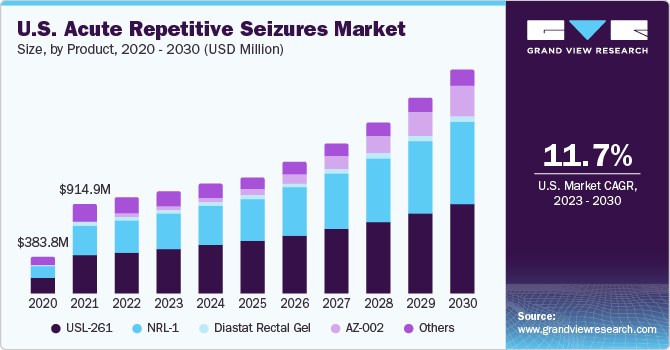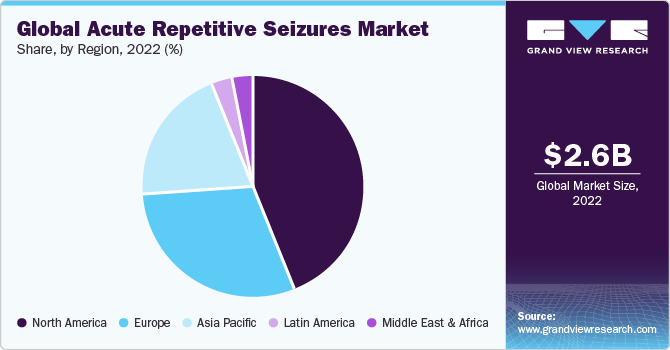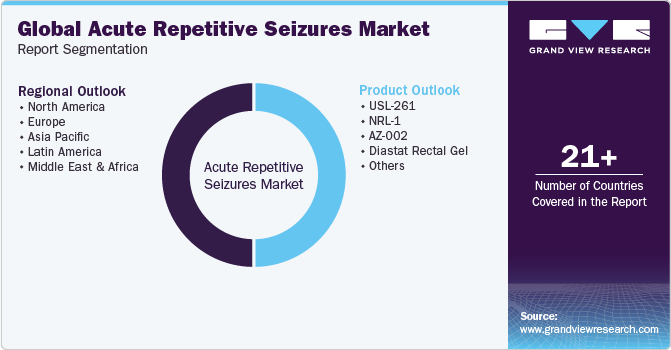- Home
- »
- Pharmaceuticals
- »
-
Acute Repetitive Seizures Market Size & Share Report, 2030GVR Report cover
![Acute Repetitive Seizures Market Size, Share & Trends Report]()
Acute Repetitive Seizures Market Size, Share & Trends Analysis Report By Product (USL-261, NRL-1, AZ-002), By Region (North America, Europe, Asia Pacific, Latin America, MEA), And Segment Forecasts, 2023 - 2030
- Report ID: GVR-2-68038-489-5
- Number of Report Pages: 87
- Format: PDF, Horizon Databook
- Historical Range: 2018 - 2021
- Forecast Period: 2023 - 2030
- Industry: Healthcare
Acute Repetitive Seizures Market Trends
The global acute repetitive seizures market size was estimated at USD 2.60 billion in 2022 and is expected to register a compound annual growth rate (CAGR) of 12.4% from 2023 to 2030. High unmet clinical needs for patients and caregivers, increased awareness of epilepsy, rising prevalence of neurological disorders, and availability of advanced product pipelines are major factors expected to propel market growth. According to World Health Organization (WHO), epilepsy is a neurological condition affecting about 50 million people worldwide. Drug therapy is effective for most patients suffering from cluster seizures. However, there are many treatment challenges and unmet medical needs, including drug-induced seizures, adverse reactions, and a lack of ant-epileptogenic agents that can prevent the development of seizures and their comorbidities.

Acute recurrent seizures can result from several things, including head injury, stroke, brain tumor, infection, and genetics. Acute repetitive seizures are usually treated with anti-epileptic drugs and, in some cases, with surgery to remove part of the brain.
In an attempt to curb healthcare expenditure, governments across the globe are making continuous efforts to reduce hospital stays, and on-site patient treatment costs through outpatient care models, such as clinic and home healthcare. Emerging economies like India and China are increasingly implementing these healthcare reforms. This factor is expected to propel the growth of the market.
The treatment gap is useful for comparing access to quality care for seizure patients. The treatment gap for low- and middle-income countries, such as India, South Africa, and Brazil, is around 80%, while it is around 60% in developed countries, such as U.S. and UK.
Among the many routes of medicine administration, patients prefer the intranasal route over other types, such as buccal, rectal, and intramuscular routes. Parenteral medications have proven to be the optimal option for outpatient treatment. However, in some countries, such as the Netherlands, caregivers are not qualified for administrating parenteral medications.
Product Insights
Based on product, the market is categorized into USL-261, NRL-1, AZ-002, diastat rectal gel (DRG), and others. The USL-261 segment dominated the market with the largest revenue share in 2022 because a caregiver can administer it without the need for a needle, and it works quickly. USL-261, which is specifically designed for intranasal delivery for outpatient usage. FDA granted it an orphan drug to meet the high demands of the drug in the market. However, the FDA accepted the new drug application for Nayzilam (USL-261).
The AZ-002 segment is expected to be the fastest-growing segment over the forecast period. Alprazolam (AZ-002) is UCB’s drug candidate for seizures and epilepsy and is in Phase 3 trial as of May 2023. The drug is administered via inhalation. It combines UCB's patented staccato system with the active ingredient (alprazolam).
The NRL-1 segment is expected to grow at a significant CAGR rate over the forecast period. It is an investigational drug developed by Neurelis to be used for children, adolescents, and adults. The company filed NDA with the FDA in September 2018. USL-261 is expected to show lucrative growth over the forecast years and is specifically designed for intranasal administration for outpatient use.
Regional Insights
North America dominated the acute repetitive seizures market with the largest revenue share of 43.4% in 2022, owing to increased epilepsy cases. Also, the total direct and indirect cost of epilepsy in this region is estimated to be around USD 15.5 billion annually. Thus, a large target population base for epilepsy drugs in this region is expected to spur market growth. Approximately 1.2% of the U.S. population has active epilepsy. This equates to approximately 3.4 million Americans.

Germany is expected to witness robust growth over the forecast period owing to technological advancements in scientific, clinical, and medical fields. Increasing demand for antiepileptic drugs due to rising disease prevalence in the region fosters market growth. Government initiatives to improve the quality of life and awareness regarding the disease, along with the promotion of better healthcare facilities, are the major drivers boosting the market growth in this region.
The Asia Pacific market is expected to grow at the fastest CAGR of 13.8% over the forecast period owing to increased healthcare expenditure in developing countries, such as India and China. A huge gap was observed in treating acute repetitive seizures in this region. There are more than 12 million and 10 million cases of epilepsy in India and China, respectively. Hence, the demand for antiseizure drugs in these developing countries encourages a shift in market potential from the already saturated European and North American regions to such economies.
Key Companies & Market Share Insights
UCB S.A. and Neurelis, Inc. are likely to hold the major share of the global market due to the commercialization of USL-261 and VALTOCO. The prices are expected to be high as both drugs are designated orphan. In addition, the preferred route of administration is nasal, which will result in higher adoption of these two drugs. Most key companies focus on business expansion strategies, such as novel product launches, acquisitions, and collaborations, to enhance their market position. For instance, in January 2022, Neurelis signed an exclusive agreement with Aculys Pharma to commercialize and develop VALTOCO in the Asia Pacific region. Aculys Pharma is based in Japan and focuses on commercializing and developing innovations in psychiatry and neurology.
Similarly, in January 2022, UCB completed the acquisition of Midazolam nasal spray (USL-61) from Proximagen to expand its epilepsy portfolio. The acquisition of USL-261 complements UCB’s already successful anti-epilepsy drug portfolio, enhancing the organization’s position in the global market.
Furthermore, in October 2021, Alexza announced the initiation of a phase 3 trial for Staccato Alprazolam which is an acute treatment for epileptic seizures. UCB Pharma is conducting trials to check the safety and efficacy of the drug. In addition, in July 2020, Takeda announced a global partnership with Ovid Therapeutics to develop and commercialize Soticlestat, a potentially effective treatment for rare epilepsy syndromes, including certain forms of acute recurrent seizures.
Key Acute Repetitive Seizures Companies:
- UCB S.A. Belgium
- Neurelis, Inc.
- Bausch Health Companies Inc.
- ALEXZA
- VERITON PHARMA
Acute Repetitive Seizures Market Report Scope
Report Attribute
Details
Market size value in 2023
USD 2.78 billion
Revenue forecast in 2030
USD 6.31 billion
Growth rate
CAGR of 12.4% from 2023 to 2030
Base year for estimation
2022
Historical data
2018 - 2021
Forecast period
2023 - 2030
Report updated
November 2023
Quantitative units
Revenue in USD Million and CAGR from 2023 to 2030
Report coverage
Revenue forecast, company ranking, competitive landscape, growth factors, and trends
Segments covered
Product, region
Regional scope
North America, Europe, Asia Pacific, Latin America, MEA
Country scope
U.S., Canada, UK, Germany, France, Italy, Spain, Denmark, Sweden, Norway, China, Japan, India, Australia, South Korea, Thailand, Brazil, Mexico, Argentina, Saudi Arabia, South Africa ,UAE, Kuwait
Key companies profiled
UCB S.A. Belgium; Neurelis, Inc.; Bausch Health Companies Inc.; ALEXZA; VERITON PHARMA
Customization scope
Free report customization (equivalent up to 8 analyst’s working days) with purchase. Addition or alteration to country, regional & segment scope
Pricing and purchase options
Avail customized purchase options to meet your exact research needs. Explore purchase options
Global Acute Repetitive Seizures Market Report Segmentation
This report forecasts revenue growth at global, regional, and country levels and provides an analysis of the latest industry trends in each of the sub-segments from 2018 to 2030. For the purpose of this study, Grand View Research has segmented the global acute repetitive seizures market on the basis of product and region:

-
Product Outlook (Revenue in USD Million, 2018 - 2030)
-
USL-261
-
NRL-1
-
AZ-002
-
Diastat Rectal Gel
-
Others
-
-
Regional Outlook (Revenue in USD Million, 2018 - 2030)
-
North America
-
U.S.
-
Canada
-
-
Europe
-
UK
-
Germany
-
France
-
Italy
-
Spain
-
Sweden
-
Norway
-
Denmark
-
-
Asia Pacific
-
Japan
-
China
-
India
-
Australia
-
Thailand
-
South Korea
-
-
Latin America
-
Brazil
-
Mexico
-
Argentina
-
-
Middle East and Africa
-
Saudi Arabia
-
South Africa
-
UAE
-
Kuwait
-
-
Frequently Asked Questions About This Report
b. The global acute repetitive seizures market size was estimated at USD 2.6 billion in 2022 and is expected to reach USD 2.78 billion in 2023.
b. The global acute repetitive seizures market is expected to grow at a compound annual growth rate of 12.4% from 2023 to 2030 to reach USD 6.31 billion by 2030.
b. U.S. dominated the acute repetitive seizures market with a share of 37.9% in 2022. This is attributable to the high incidence of epilepsy, the presence of a large target population base, and the high total direct and indirect cost of epilepsy in the country.
b. Some key players operating in the global acute repetitive seizures market include UCB S.A. and Neurelis, Inc. They are likely to hold the majority of share in the global market due to the commercialization of USL-261 and VALTOCO products respectively.
b. High unmet clinical needs for patients, as well as caregivers, and the availability of advanced product pipeline are some of the major factors expected to propel market growth.
Share this report with your colleague or friend.
![gvr icn]()
NEED A CUSTOM REPORT?
We can customize every report - free of charge - including purchasing stand-alone sections or country-level reports, as well as offer affordable discounts for start-ups & universities. Contact us now
![Certified Icon]()
We are GDPR and CCPA compliant! Your transaction & personal information is safe and secure. For more details, please read our privacy policy.
We are committed towards customer satisfaction, and quality service.
"The quality of research they have done for us has been excellent."





